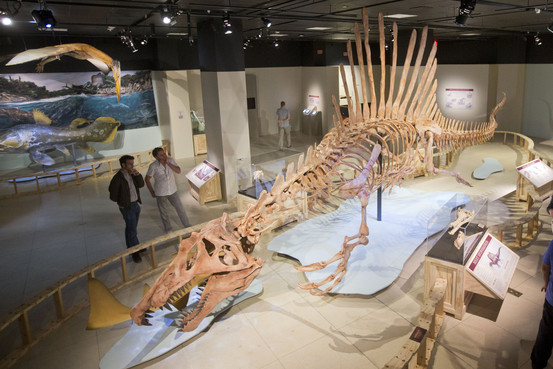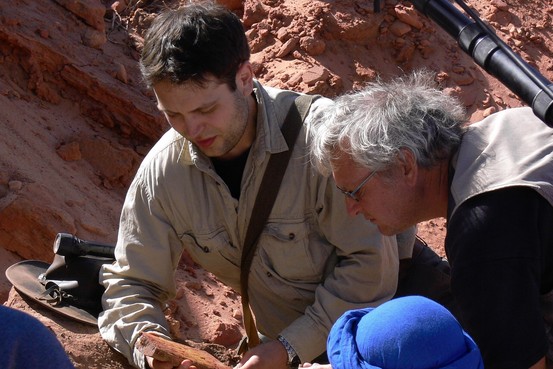- Tel: +86 813 2105845
- Fax: +86 813 2105845
- Mob: +86 13778532392
- Contact: Mr. Jacky
 info@dinosaurs-world.com
info@dinosaurs-world.com Jackydinosworld@gmail.com
Jackydinosworld@gmail.com Jackyyiming@gmail.com
Jackyyiming@gmail.com Jackyzengdinosaursworld
Jackyzengdinosaursworld
- Scientists Identify First Swimming Dinosaur
A rich horde of fossils from the Sahara has revealed that the largest known predator to ever walk the earth was also a superb swimmer, overturning the common view that dinosaurs were terrestrial beasts.
In a study published Thursday in the journal Science, an international research team described how it had uncovered the partial skeleton of a semiaquatic dinosaur, Spinosaurus, in Morocco. They estimate that the creature—not yet fully grown—measured 50 feet, at least nine feet longer than the largest documented Tyrannosaurus rex.
"We've resurrected a giant from deep time…a lost world buried for more than 95 million years," said Nizar Ibrahim, a paleontologist at the University of Chicago and lead author of the study. "It is arguably the most enigmatic dinosaur" yet described.
The tale of Spinosaurus, which goes back to a cache of mysterious fossils discovered a century ago, opens a new chapter in our understanding of how some of these dinosaurs lived, evolved and ruled the earth for more than 130 million years.
Spinosauraus was an odd and fearsome predator. In addition to seven-foot-tall spines that protruded from its back and inspired its name, it had powerful forelimbs tipped with blade-like claws and an elongated snout stacked with giant conical teeth.
Fossils of a Spinosaurus, seen in a life-size model, were found in Morocco. Associated PressOther dinosaurs very likely caught fish without needing to swim. For example, a long-snouted creature known as Baryonyx had a large claw that would have done the job well.
The Spinosaurus enigma has persisted for a long time. In 1915, a German paleontologist called Ernst Stromer described an unusual giant predator based on fossils from Egypt. He named the creature Spinosaurus aegyptiacus: the Egyptian spine lizard.
Unfortunately, Stromer's fossils were largely destroyed during the Allied bombing of Munich, Germany, in April 1944. All that survived were his meticulous notes, sketches and photos. Ever since, scientists have been on the hunt for the elusive Spinosaurus.
During a 2008 field trip in Morocco, Dr. Ibrahim chanced upon an unusual blade-shaped bone in the possession of a local fossil hunter. He thought it looked like the Spinosaurus' distinctive spine. He later concluded that it must originate from the very same animal whose partial skeleton had come into the possession of an Italian museum.
Dr. Ibrahim returned to Morocco and began an exhaustive search for the fossil hunter. Once again, he found him in a chance encounter."It was something of a Mission Impossible, finding this one man in the Sahara," Dr. Ibrahim recalled.
But for the scientists involved in the Morocco dig, the dinosaur's apparent adaptation to water was its most striking feature.
The body shape of Spinosaurus indicates the animal would have found it easy to swim but exceedingly difficult to walk. The nostrils were located farther back on the skull so the animal could breathe when part of its head was submerged. The limb proportions—muscular thighs, short hind legs—were more typical of the ancestors of modern whales.
The notion of swimming dinosaurs "will lead us to rethink a lot of things, such as how they might have dispersed" among distant land masses, said Hans Sues, senior scientist and curator at the Smithsonian National Museum of Natural History in Washington, D.C., who wasn't involved in the study.
Some paleontologists have speculated that very large dinosaurs, such as sauropods, could have been aquatic because of their immense weight. But there was little hard evidence to go on. So the terrestrial view largely prevailed.
Paleontologists Nizar Ibrahim and David Martill. Cristiano Dal Sasso
The man led Dr. Ibrahim to a fossil-rich area known as the Kem Kem beds in eastern Morocco, where he had unearthed the original fossils. It was the site of an ancient river system once populated by sharks, coelacanth fish as large as a car, and at least three T-Rex-sized carnivores.
There, Dr. Ibrahim and his team recovered a trove of fossils from a single Spinosaurus, including parts of its skull, axial column, pelvic girdle and limbs. Those pieces were digitally matched to Stromer's records and bits of fossils from various museums, eventually yielding a life-size version of Spinosaurus.
Hollywood has already cemented Spinosaurus' reputation as a fierce predator. In the 2001 film, Jurassic Park 3, the animal has a fatal jungle duel with a T-Rex, which Spinosaurus wins.
But Hollywood may have gotten it wrong. The producers "would have to go back to the drawing board," said Paul Sereno, a co-author who is also at the University of Chicago.Given that Spinosaurus was built more for the water, "the evidence suggests it couldn't balance for a long period on its hind legs."


 2014-09-24
2014-09-24
 New dinosaur species help scientists fill in evolutionary gaps
New dinosaur species help scientists fill in evolutionary gaps Feathered everything: just how many dinosaurs had feathers?
Feathered everything: just how many dinosaurs had feathers? Dinosaur Fossil With Fleshy Rooster's Comb Is First of Its Kind
Dinosaur Fossil With Fleshy Rooster's Comb Is First of Its Kind Scientists finally decode how dinosaurs turned into birds and learned how to fly
Scientists finally decode how dinosaurs turned into birds and learned how to fly Dark matter may have killed the dinosaurs, claims scientist
Dark matter may have killed the dinosaurs, claims scientist New duck-billed dinosaur uncovered in Alaska, researchers say
New duck-billed dinosaur uncovered in Alaska, researchers say
- Contact Us
- Tel: +86 813 2105845
- Fax: +86 813 2105845
- Contact: Mr. Jacky
 info@dinosaurs-world.com
info@dinosaurs-world.com Jackydinosworld@gmail.com
Jackydinosworld@gmail.com Jackyyiming@gmail.com
Jackyyiming@gmail.com Jackyzengdinosaursworld
Jackyzengdinosaursworld
- Copyright @ 2009 - 2020 Zigong Dinosaurs World Science & Technology Co.,Ltd.

